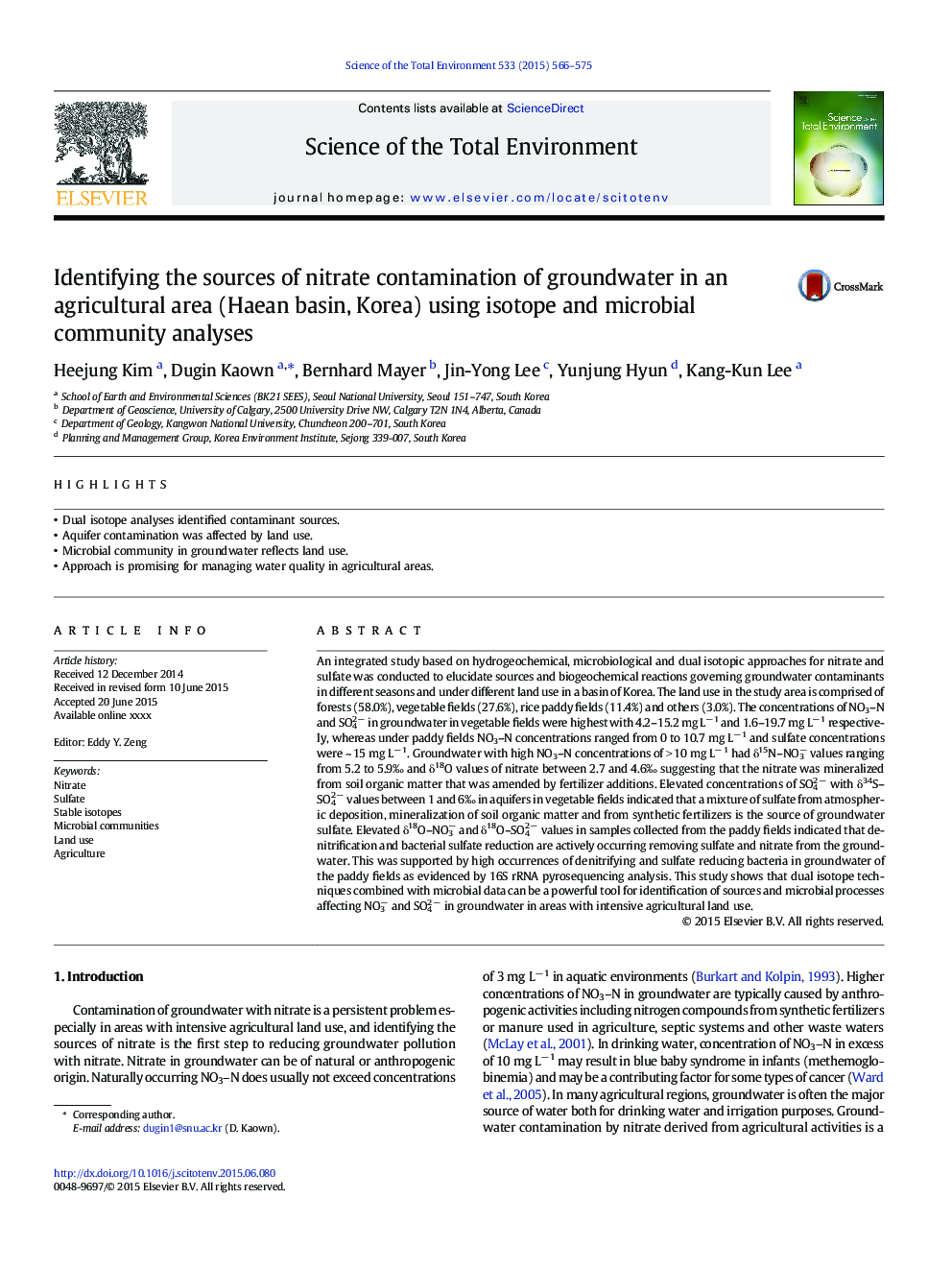| کد مقاله | کد نشریه | سال انتشار | مقاله انگلیسی | نسخه تمام متن |
|---|---|---|---|---|
| 6326339 | 1619751 | 2015 | 10 صفحه PDF | دانلود رایگان |
عنوان انگلیسی مقاله ISI
Identifying the sources of nitrate contamination of groundwater in an agricultural area (Haean basin, Korea) using isotope and microbial community analyses
ترجمه فارسی عنوان
شناسایی منابع آلودگی آبهای زیرزمینی نیترات در یک منطقه کشاورزی (حوضه حین، کره) با استفاده از تجزیه و تحلیل جامعه ایزوتوپ و میکروبی
دانلود مقاله + سفارش ترجمه
دانلود مقاله ISI انگلیسی
رایگان برای ایرانیان
کلمات کلیدی
نیترات، سولفات، ایزوتوپهای پایدار، جوامع میکروبی، استفاده از زمین، کشاورزی،
موضوعات مرتبط
علوم زیستی و بیوفناوری
علوم محیط زیست
شیمی زیست محیطی
چکیده انگلیسی
An integrated study based on hydrogeochemical, microbiological and dual isotopic approaches for nitrate and sulfate was conducted to elucidate sources and biogeochemical reactions governing groundwater contaminants in different seasons and under different land use in a basin of Korea. The land use in the study area is comprised of forests (58.0%), vegetable fields (27.6%), rice paddy fields (11.4%) and others (3.0%). The concentrations of NO3-N and SO42 â in groundwater in vegetable fields were highest with 4.2-15.2 mg Lâ 1 and 1.6-19.7 mg Lâ 1 respectively, whereas under paddy fields NO3-N concentrations ranged from 0 to 10.7 mg Lâ 1 and sulfate concentrations were ~ 15 mg Lâ 1. Groundwater with high NO3-N concentrations of > 10 mg Lâ 1 had δ15N-NO3â values ranging from 5.2 to 5.9â° and δ18O values of nitrate between 2.7 and 4.6â° suggesting that the nitrate was mineralized from soil organic matter that was amended by fertilizer additions. Elevated concentrations of SO42 â with δ34S-SO42 â values between 1 and 6â° in aquifers in vegetable fields indicated that a mixture of sulfate from atmospheric deposition, mineralization of soil organic matter and from synthetic fertilizers is the source of groundwater sulfate. Elevated δ18O-NO3â and δ18O-SO42 â values in samples collected from the paddy fields indicated that denitrification and bacterial sulfate reduction are actively occurring removing sulfate and nitrate from the groundwater. This was supported by high occurrences of denitrifying and sulfate reducing bacteria in groundwater of the paddy fields as evidenced by 16S rRNA pyrosequencing analysis. This study shows that dual isotope techniques combined with microbial data can be a powerful tool for identification of sources and microbial processes affecting NO3â and SO42 â in groundwater in areas with intensive agricultural land use.
ناشر
Database: Elsevier - ScienceDirect (ساینس دایرکت)
Journal: Science of The Total Environment - Volume 533, 15 November 2015, Pages 566-575
Journal: Science of The Total Environment - Volume 533, 15 November 2015, Pages 566-575
نویسندگان
Heejung Kim, Dugin Kaown, Bernhard Mayer, Jin-Yong Lee, Yunjung Hyun, Kang-Kun Lee,
